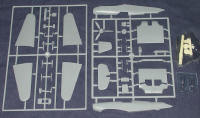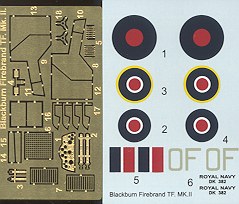
|
KIT: |
Valom 1/72 Firebrand II |
|
KIT # |
72006 |
|
PRICE: |
$36.98 (29.96 at Squadron) |
|
DECALS: |
One option |
|
REVIEWER: |
Scott Van Aken |
|
NOTES: |
Short run with etched, resin and vac parts. |

|
HISTORY |
The first of three prototypes first flew in Feb of 1942. Trials showed a need for improved tailplane and elevators, this being done before A&AEE testing was done during June and July of 1942. It was shown that larger flaps were needed to improve carrier landing and the pilots complained of distortion in the windscreen quarter panels. The second machine was armed and undertook trials in October of 1942, with the first deck trials taking place in Feb 1943. The third prototype was delivered for armament trials in May 1943.
A redesigned engine mount was done on the first prototype to make engine changes easier. After five of the Sabre engines were built, it was decided to prioritize Sabre production to the Typhoon, leaving the Firebrand somewhat in the lurch. The success of the Seafire also meant that it was without a role. Thanks to its good load carrying capabilities, it was decided to fit it out as a Torpedo/Strike Fighter.
In accordance, the second prototype was rebuilt and increased in width so that it could carry an 18" 1,850 lb torpedo. This was the first Firebrand TF.II. Nine of the already built and unmodified Firebrand F.Is were used for various trials, with most being broken up with very few hours on the airframes. The TF.II was only built in very small number, 12 to be exact. These were used by only one squadron, 708Sq a shore-based trial unit. Eventually the Firebrand matured into a very capable airframe, but by that time, the need really wasn't there and as a result, though the TF.5 was a capable aircraft, it was produced in small numbers and eventually replaced in 1953 by the Wyvern.
|
THE KIT |
 Though
numbered 006, this is actually the fourth Valom kit done. Like the
previous ones, it is of a subject that are perfect for short run
companies and a subject that the 'big boys' wouldn't touch. Most short
run kits from Eastern Europe rely on etched metal frets, resin detail
parts and vacuformed canopies. This one is no exception in that regard.
However, the reliance on these exotic materials is reduced from previous
efforts. Resin is used for the torpedo, wheels and a 'bump' on the
leading edge of the wing. Etched metal is used for a few interior parts
like rudder pedals and instrument panel. It is also used for intake
grilles and for the main landing gear doors. Two vacuformed canopies are
provided.
Though
numbered 006, this is actually the fourth Valom kit done. Like the
previous ones, it is of a subject that are perfect for short run
companies and a subject that the 'big boys' wouldn't touch. Most short
run kits from Eastern Europe rely on etched metal frets, resin detail
parts and vacuformed canopies. This one is no exception in that regard.
However, the reliance on these exotic materials is reduced from previous
efforts. Resin is used for the torpedo, wheels and a 'bump' on the
leading edge of the wing. Etched metal is used for a few interior parts
like rudder pedals and instrument panel. It is also used for intake
grilles and for the main landing gear doors. Two vacuformed canopies are
provided.
The plastic itself doesn't seem as 'clunky' as on earlier kits and I'm
delighted to see the prop and spinner cast as a single piece. It seems
Valom agrees that you don't have to have a zillion small parts when just
a few will do just as well. Trust me, we don't feel cheated at all by
having one molding where some will make it into a 6 part construct! The
kit has engraved detail which seems very good for this scale. The fin and
tailplane are a single solid mold, yet there are no sink areas. There
also is no flash and the only place I found ejector towers (and they are
very small) is ins ide the
fuselage where they won't be seen or get in the way of construction. The
interior is rather complete for a fighter and includes a tub, seat,
stick, rudder pedals and some small etched knobs and switches. The etched
seat belts will add quite a bit to it, though really, the cockpit opening
is rather small so little will be seen. Several of the etched parts are
for the torpedo fins and propellers. The vac canopies are well done with
good frame detail and are quite clear.
ide the
fuselage where they won't be seen or get in the way of construction. The
interior is rather complete for a fighter and includes a tub, seat,
stick, rudder pedals and some small etched knobs and switches. The etched
seat belts will add quite a bit to it, though really, the cockpit opening
is rather small so little will be seen. Several of the etched parts are
for the torpedo fins and propellers. The vac canopies are well done with
good frame detail and are quite clear.
Instructions are quite good with color information provided for Humbrol, Agma, Gunze Sangyo, ModelMaster and FS 595 references where applicable. Bascially you have your Extra Dark Sea Grey/Dark Slate Grey over Sky camo scheme. Decals are small but sufficient with codes for what I assume is 708 Sq. They are very well printed and experience has shown them to be very opaque as well.
|
CONCLUSIONS |
Overall, this looks like it is the best of the lot so far. Detailing is super and the fact that Valom is relying less and less on 'exotic' materials, is a good sign, though I doubt if they'll ever really wean themselves from it. I should also mention that Valom packages all the bits inside a nice zip bag, which makes it much easier to keep track of the parts once you have opened the kit to fondle the plastic. I wish other manufacturers would do the same.
|
REFERENCES |
Blackburn Aircraft since 1909, AJ Jackson, 1989,
Naval Institue Press, ISBN 0-87021-024-6 You can find this kit and many others at
Thank you to VALOM for sending in a review sample. If you would like your product reviewed fairly and quickly by a
site that has over 250,000 visitors a month, please contact
me or see other details in the
Note to
Contributors.